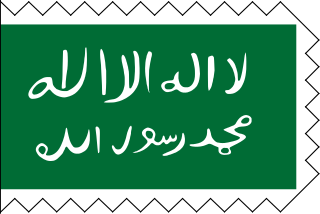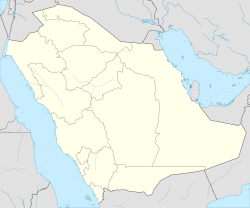
Asir, officially the Asir Province, is a province in the southwest of Saudi Arabia, which is named after the ʿAsīr tribe. It has an area of 76,693 square kilometres (29,611 sq mi), and an estimated population of 2,024,285. ʿAsīr is surrounded by Mecca Province to the north and west, Al-Bahah Province to the northwest, Riyadh Province to the northeast, Najran Province to the southeast, and Jazan Province and the Yemeni Muhafazah (Governorate) of Saada to the south.

The Azd, or Al-Azd, is an ancient Arabian tribe. The lands of Azd occupied an area west of Bisha and Al Bahah in what is today Saudi Arabia.
AITF also known as Aitf Al-Salim, is a village in the sub-governorate of Bariq in the province of Asir, Saudi Arabia. It is located at an elevation of 432 metres (1,417 ft) and has a population of about 500 to 1,000.
Al-Ghamdi is an Arabic family name denoting a member of the Ghamd tribe of Saudi Arabia.
The Banu Shahr is a tribe from the southern part of the Arabian Peninsula. It belongs to the ancient tribe al-Azd that has many clans linked to it. As far as ancestry goes, Banu Shahr, Bani Amr, Bal-Ahmar, Bal-Asmar, Bal-Qarn, Shumran, and some others all belong to "al-Azd".

The Idrisid Emirate of Asir was a state located in the Arabian Peninsula. The Emirate was in the geographical region of Asir and Jizan, in what is now southwestern Saudi Arabia, and extending to Hodeidah, northwest of Yemen.
The Ghamid is an Azd Arab tribe of the Hejaz Region. They are predominantly Sunni, and are considered one of the oldest tribes of the Arabian Peninsula. The Ghamid people are thought to be closely related to the neighboring tribe of Zahran.
Bariq is a tribe from Bareq in south-west Saudi Arabia. It belongs to the ancient Al-Azd tribe which has many clans linked to it. As far as ancestry goes, Aws, Khazraj, Ghassān and Banu Khuza'a, and others all belong to Al-Azd. They were one of the tribes of Arabia during Muhammad's era.
Humaydah ibn an-Nu'man al-Bariqi, was a companion of Muhammad. He was the leader of the tribe of Bariq and an extremely successful military general during the reign of Rashidun Caliph Umar. Humaydah also fought under Sa`d's command against the Sassanid army at the Battle of al-Qādisiyyah.

Jabal Atherb is a mountain in Bareq, Saudi Arabia. The mountain consist primarily of sedimentary rock of Jurassic, Cretaceous, and Tertiary origin.
Humaydah, is an Arab tribe, a subgroup of the Bariq tribe of the Qahtanite people. They were a powerful house which governed the city of Bareq until the Ibn Saud invasion and lived peacefully beside al-Ali.
Ajama also known as Suq-El-Ajama or Rabu' el-A'jama , Arabic: العجمة) is a village in the sub-governorate of Bariq in the province of Asir, Saudi Arabia. It is located at an elevation of 375 metres (1,230 ft) and has a population of about 1,000 to 2,000 naming comes from Al-Ajmeh - by opening the neglected eye, al-Jim and al-Mim - and al-Ajmeh, as the linguists originally put it, is al-Sakhr al-Salab, which is the well-known limestone.. It was the capital of The Humaydah tribe. Kinahan Cornwallis Said (1916), suq el-ajamah a large village of about 300 stone houses, former seat of a Turkish markaz and the most important market of the neighbourhood.

Munaydhir is a village in the sub-governorate of Bariq in the province of Asir, Saudi Arabia. It is located at an elevation of 382 metres (1,253 ft) and has a population of about 500 to 2,000.
Farah, Arabic: الفرعة) is a village in the sub-governorate of Bariq in the province of Asir, Saudi Arabia. It is located at an elevation of 469 metres (1,539 ft) and has a population of about 500 to 1,000. It is connected with the main road by a 6.2 Kilometer.
Qafeel, is a neighborhood in the sub-governorate of Bariq in the province of Asir, Saudi Arabia. It is located at an elevation of 390 metres (1,280 ft) and has a population of 5,000. It is one of the largest neighborhoods of Bareq.
Bariq was founded in 220 AD. It is part of the territory known historically as Yemen, which dates back to the second millennium BC. It was inhabited by immigrant tribes of southern Yemen called Bariq, who belong to the ancient tribe Al-Azd which has many clans linked to it.

Gdraymah is a town in the sub-governorate of Bariq in the province of Asir, Saudi Arabia. It is located at an elevation of 460 metres (1,510 ft) and has a population amounts to 5,000 (2010).
Bilad al-Musa is a village in the sub-governorate of Bariq in the province of Asir, Saudi Arabia. It is located at an elevation of 435 meters and had a population of 5,000 in 1970. It is connected with the main road by a 3 kilometer road. The headman is Ahmed Hiyazah Fayiz Hiyazah.
Al-Qarn also known as Qarn Mikhled, is a village in the sub-governorate of Bariq in the 'Asir Province, Saudi Arabia. It is located at an elevation of 370 metres (1,210 ft) and has a population of about 500 to 2,000. It is best known for being the birthplace of Uwais al-Qarni.

Muzayqiya, real name 'Amr was the leader of the Azd tribes and a king ruling parts of Yemen in the 2nd century CE. Muzayqiya succeeded his brother Imran in the leadership of the kingdom. During his time, the Ma'rib Dam collapsed which resulted in several Qahtanite tribes emigrating from Yemen.













